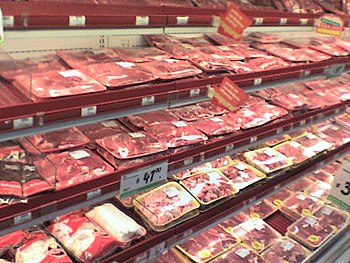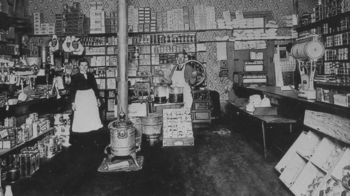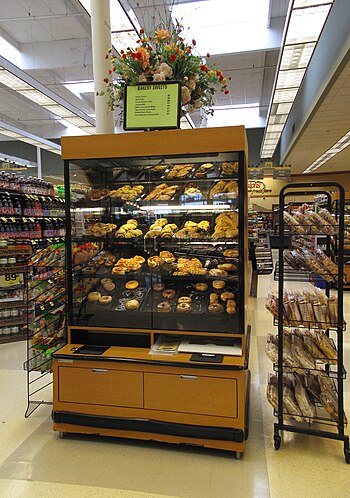The Man’s Guide to Grocery Shopping
Odds are you are not crazy about grocery shopping. Regardless, we have to eat so here are a few things to look for or to avoid during your grocery store recon.
If you are cruising for women, shopping at a major grocery store between 7 and 10:00 PM (nighttime for the clock impaired) is a good time. Most single working women are doing their shopping in this time frame and guess what? a good portion of them are actually cruising for guys-because this is the same time frame in which single guys shop for groceries.
At one time years ago, many major cities actually had “sort of” date night shopping once a week where men and women would shop for food-and each other. Store promotion of this was strictly word of mouth of course.
Okay, assuming you are “just” after food, let’s begin with the basics. In nearly all grocery stores they have special lighting over the produce and meat departments. These specialized (sort of blue) overhead lights in the produce departments help accentuate the green color in the greens in that section. The stores also have a different wavelength (warmer light) light to accentuate colored veggies like apples, etc.
While here with the lighting the stores will have specialized red wave length lights help accentuate the red color of meat in the above the meat counter. Grocery operations have known for decades that women, who do most of the grocery shopping, look for the brightest red meat (more on this later).
So if you want an accurate color read for the particular item you are looking at simply shield the item from the special lighting and in the meat section just remove the (packaged) product a few feet from the meat case lights.
All this lighting stuff is legal and proper marketing much as are the special wavelength lights in jewelry stores that accentuate diamond’s colors and brilliance.
Grocery stores are nearly all computer designed for the best sales. Why not, they are not cheating you, just maximizing their sales, so no sniveling on your part.

Produce aisle-may use special lights to make greens look better-note the blue effect. (Photo credit: Wikipedia)
For the last 40 years most stores shelves have been “set” by computer systems based on sales, inventory and much more. The system will tell them which shelf, how many linear facings (can/box fronts), how stacked, what shelf, how high and where in the particular section to position that inventory.
If it is a sale item, the system will tell them all of the previous information and also what regular priced item to have near it because store management knows there is a purchase bleed from the sale item to full priced items. Many companies actually pay the grocery store (lot of money if it is a big chain) a special display payment to promote their items in the store up front and on end caps (end of aisles).
The flow and aisle design of grocery stores is of course very carefully designed to run a shopper past every possible product they can while they search for what they really came in the store for. Even those with shopping lists will do some spontaneous purchasing-especially men! We buy fun stuff!
If your store has a last day bargain meat section-shop the hell out of it. That meat is NOT going to be recycled into ground beef nor is it allowed to be donated-the next day when expired, it is thrown out! Expired dairy items may be donated to charities by the stores, and they usually are too because dairy items have a “longer grace period” after the official expiration date than does meat. The discounted meat section is a bargain!
What about reddish brown or non-blood red meat? Back in the day when shoppers knew what the hell they were doing, meat that was blood red just was not desired. Smart shoppers looked for darker red meat. This was and is meat that had some aging to it where friendly bacteria made it more tender and flavorful and where you were not paying for liquid blood which is basically red water.
Properly aged meat is generally dryer and more concentrated and much richer in flavor. And, for what it is worth, the close out sale meat is a better deal as it has some in package aging to it. The flavor is much better than the day’s recent bloody looking red meat that most shoppers are more attracted to and the meat is more tender than its fresh on the shelf counterparts. Generally, shoppers past 65 year of age will look for the darker and older meat; they remember the way meat was once sold decades earlier.

Special red wavelength lights make red meat look better to amateur shoppers. (Photo credit: Wikipedia)
As recent as just 30- yeas ago most beef in most grocery stores had been aged for 14-21 days or sometimes longer. Nowadays the meat you may buy may have come from an animal killed the day before, if that old. Custom meat shops may have aged meat, and it will cost more since there is some waste involved in the aging process, but the flavor is much better as well as more tender.
Some packaged hams (most all) and packaged bacon will have extra salt water injected in the product-a normal “flavor enhancing” procedure. This makes them heaver and you end up paying for expensive salt water. This can also apply to some turkey and chicken products, but not like it does for hams and bacon. You will notice the bacon most as copious amounts of steam and water emerge when cooking. Buy thicker sliced fresh sliced bacon for the best deal, even though it will cost more-it is still a better buy.
Being food quality paranoid, packaged frozen fish is always suspect. We simply will NOT buy fish that is farm raised; they put all kinds of “stuff” in that food chain. Many fish that are actually cold water fish (like North Atlantic Salmon) are now farm raised in warm and hot climes in the south and even further south in Central America, etc. The mushy flesh and off flavor just suck compared to fish wild caught from their own real world wild environment. We aggressively avoid foreign raised, caught or processed “fresh/frozen” fish.
We will buy wild caught U.S. and Canadian fish like cod and salmon. Catfish are a warm water fish and fare a better even if farm raised in the U.S. or Canada, but not elsewhere. Just read the label for the source.
Some “fresh” fish in store fish counters including crab and shrimp is actually from the same fish in the packaged frozen counter. The store will remove it from the package, thaw and sell it in a display case. Not illegal, but you will not know the source unless you ask, and unless they are liars, they will tell you the source of the fish and if it was previously frozen. Recently there has been issued some type of warning regarding shrimp for the 2015 season.
Produce is fairly easy to purchase. Brown is bad unless it is a kiwi or plantain. Soft or bruised is bad. Buy hard, bruise free, well colored, firm fruit and veggies and let them ripen in your residence, then you know. Lettuce and other greens are best not aged! Buy fresh and eat them soonest. When looking at produce, examine the whole thing if you can. Buying a great looking apple and later finding the worm hole or fungus on the other side is really ugly. Fully inspect your produce before purchasing.
The heavier the head of lettuce the better, same for garlic-lettuce is generally sold by the head and not the pound-which makes the heavy heads a better buy as they will have more leaves. Watch cauliflower for lots of short cut stalk a result of bad trimming and of course when sold by the pound you pay for the inedible trimmings you cut off and throw out. This alone can make up nearly half the weight of the cauliflower.
Cauliflower steamed (boiled) and once completed, stick some thin sliced Swiss or provolone cheese (sliced thin) on it using toot picks to hold it in place while it melts. This is good stuff.
Many big chains have gone to second grade produce to keep from having to raise prices, because produceis one area where shoppers tend to remember last week’s price. While it may taste decent second grade produce is full of bruises, bruises, odd shapes, tree rubs, split pits (peaches and apricots) and much more that does not allow them to make grade one and in some cases not even make grade 2.
Lessor cherries will have lots of little bumps, wrinkled skin, odd shapes, some splitting, etc. Grapes will be soft and mushy. The heavier the orange the better-more juice, and yes more expensive as oranges are sold by the pound, but light weight oranges are like eating paper-generally due to some sort of freeze damage.
There is more to this but hopefully we have raised your awareness of grocery shopping. Always look at the unit or per-pound price when shopping, especially cheeses-we will have more on that particular subject shortly, look for it as that is a sort of serious ripoff.
When you are ready to prepare that best meal for your special person–use the good stuff–then again learning to cook might help!
A bit of store layout psychology:
Back in the 1920s and earlier shoppers simply gave a shopping list to the store and the store personnel would fill the list for the shopper to pick up at the cash register. At that time store many aisles ran across the store. Then, probably the Safeway chain, realized that they could sell more food easier if they let shoppers (almost always women) do their own shopping.

Interior of a dry grocer (no produce or frozen-very rare back then), downtown Vancouver, Washington, circa 1909. (Photo credit: Wikipedia)
But the crosswise aisles made women feel uncomfortable as it created canyons of shelves and hid them from the front windows and viewing by store personnel. Soon all stores ran the aisles as they are today so that the windows and front of the store could viewed down the aisles-no more dark canyons hidden from view-women felt more secure for self-shopping.
Grocery carts are much larger nowadays than 30 years ago. Again the psychological ploy is to have shoppers buy (fill) more items. The large carts psychologically promote more buying, larger purchases and bigger sales.
Of course in store wall colors, overall displays and lighting and how produce and other displays are set matters in a well run store. Remember, the stores are not forcing you to buy anything, they are simply trying to maximize their sales and profits. The store is not your enemy or competitor. What they are doing is legal, proper, and good marketing and so is your knowing about it so you can make smarter buying decisions.

Leave a Reply